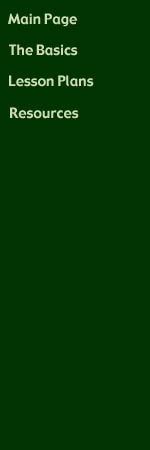

Writing a Lesson Plan
(printable version here)
Components of a Lesson Plan
Kagan and Tippins describe the function of this form of writing to, "help student teachers (a) meet immediate personal needs, like finding a sense of direction; (b) collect and organize materials; and (c) aid memory during presentation" (qtd. in Clark and Yinger 479). The Education Department at the University of Richmond further elaborates on the parts of a Lesson Plan. Each lesson should include:
- Introduction: This section lists the lesson topic, estimated time to complete the lesson, and the corresponding Virginia State Standard of Learning (SOL) which is the main focus of the instruction.
- Learning Objectives: See below for good and bad examples
- Introduction/Anticipatory Set: As with any sample of writing, the beginning must capture the audience's, or in this case, the students' attention.
- Ideas for Anticipatory Sets: recording what they already know about the subject, predicting the outcome of the activity, reviewing necessary vocabulary, or showing a video clip that the activity will expand upon.
- Lesson Development: This should be the most detailed section of the lesson. Here, writers should outline the sequence of the activities to show how students will gain an understanding of the new topic.
- Closure: This would be the equivalent to your concluding paragraph. You want to remind students what they learned for the day and how their new knowledge raises additional questions to be investigated.
- Homework
- Assessment: There are two types of assessment:
- Formative Assessment: During the course of the lesson, the teacher should have a technique to evaluate the students' progress. This type of assessment is usually not graded, but rather serves as a checkpoint for the teacher to observe where any students are misunderstanding the concept.
- Summative Assessment: This form of assessment occurs at the culmination of the lesson. Students should be evaluated on the basis of achieving the Learning Objective (See below for an example).
How to Begin Writing a Lesson Plan
Think about the different learners in the classroom. Refrain from gravitating only towards the instructional techniques that worked for you in school.
Consider using the concept of Backwards Design. Before beginning the writing process, you should first determine what specific content or skills you wish the students to master at the end of the lesson. Then, think about what activities will lead students to this end goal.
How to Write Objectives in Lesson Plans
The key to writing objectives is to begin with a verb. DO NOT use verbs such as Learn, Understand, Discuss, Explain, or Review, as these do not specify exactly how students will demonstrate their knowledge. There is more than one way to Learn or Understand a concept. DO use specific action verbs that will explain exactly what the students will be doing during the lesson.
A Few Good Examples of Lesson Plan Objectives
- Students will label the four lifestages of a frog.
- Students will compare the results of World War I and World War II using a Venn Diagram.
- Students will order color blocks into a pattern.
A Few Bad Examples of Lesson Plan Objectives
- Students will learn the lifestages of a frog.
- Students will explain the results from World War I and World War II.
- Students will review patterns.
How to End a Lesson Plan
Compare your objectives with the formative and summative assessments. The assessments should evaluate if students accomplished the learning objectives.
Example: For homework (Summative Assessment), students will color, cut, and paste the four stages of frogs onto a piece of construction paper. They will then label each stage prior to the handout being collected and graded using a rubric.
Why is it Important to have the Skills to Write a Lesson Plan?
As with any other subject, writing forces students to use their own critical thinking skills. As one student remarks in Sommers and Saltz's case study on College Freshman, "Writing lets you think and shows you how you think about thinking" (130). Analysis through writing is important for learning in any department, but writing Lesson Plans is the only way to prepare for the culminating experience of Student Teaching.
Previous Lesson Plans may be able to be used during your semester of Student Teaching. Even more so, the writing process supports teachers to create a clear, logical, and sequential order for instruction. This ensures that teachers present material in a way that builds upon prior concepts.
Other Disciplines | Writer's Web | Writing Center | Make
an Appointment | Library | Department of Education
Copyright Info